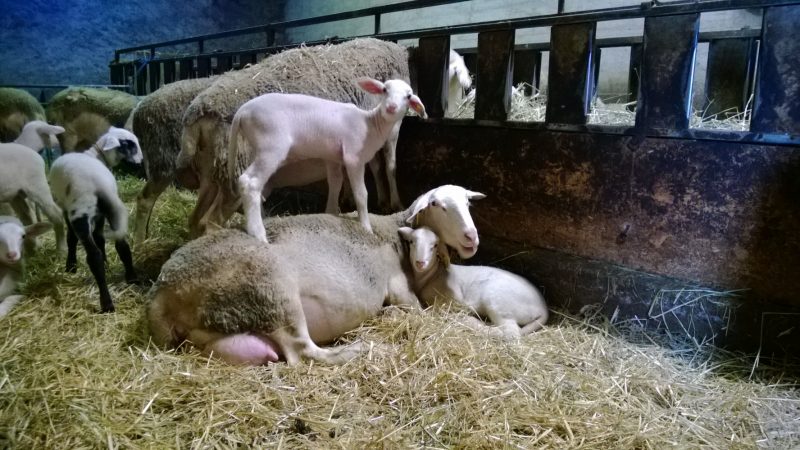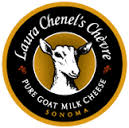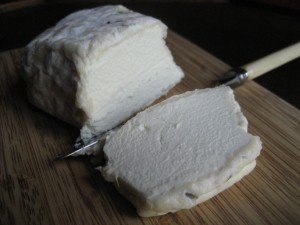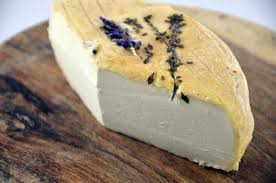Cheese is a feminist issue. You either have the mammaries or you don’t. As a cheeseaholic myself, I’m ultra-aware of the difference between the sexes – just go try milking a bull, a ram or a billy goat and you’ll get ample proof of the basic uselessness of the male animal in a mammary-orientated situation. This reality can lead to heated arguments with vegetarians who refuse to eat meat, but are happy to indulge in cheese and other dairy products.
So far (and fortunately, I’d say) cows and ewes and goats still need to get pregnant and give birth in order to provide milk. About half of all the resulting cute little beasts have the natural potential to be raised for this purpose in their turn but the other half play a different role. It’s the sad truth, guys, that only very few of you are really needed to keep this game going, and therefore eating young male animals seems a sensible thing to me.

Back to milk though. The raw milk debate has been raging ever since pasteurization was introduced for milk in late nineteenth century, but it’s seldom mentioned in that context that women are natural providers of raw milk. Maybe it’s because I have been breastfed, surviving on the sweet white stuff during the first months of my life, that on walking into a small, hands-on active dairy I’m totally seduced by the wonderful smell. Warm, lactic and enveloping, it always seems to remind me of some immemorial time, some existential way of being… it’s like cuddling a freshly bathed young child in your arms or imagine swimming in a big pool of frothy milk (call me Cleopatra, but warm milk does make for super-soft skin). However, that’s not what I plan to discuss here. Rather I’d like you to consider the fact that the surge of artisanal cheesemaking in the USA as well as my home country Germany during the last decades has been carried and flourished to a decisive part by women. Might sound like jumping to conclusions but definitely worth a thought or two: are women better cheesemakers?
Before introducing you to some of my favourite cheesemakers in the search for an answer to this potentially provocative question, let me tell you a bit more about my own point of departure. When I decided to train as a professional chef in the early 1980s (a move that would eventually lead to wine and from there to my present infatuation with cheese) vacancies in Berlin, my home town, were thin on the ground due to all the other baby boomers born like me in the early 1960s. At the same time, I saw my innocent female self confronted with arguments I thought our mothers’ generation had confined to the dustbin of historic inequality for good. The pots and pans would be heavy, they told me, all of them men of a certain age, and when that didn’t seem to shock me enough as I wasn’t exactly a slight frame myself, they’d adopt a kind of conspiratorial look, lower their voice, bend forward and say: „And besides that, you know, women in the kitchen are a real problem. On certain days they make stuff turn sour…“ It took me a moment to get what they were talking about, and then I was so completely flabbergasted I even forgot to laugh. That proved to be the salvation: my last interviewer must have deemed me either too innocent to last long enough to even get in touch with the „stuff“. Or he thought I might after all be trusted with a certain level of personal hygiene. Either way, cooking and kitchens became my new way of life.
Neither stock nor milk turned sour on certain days, but I had been put on high alert to detect even the slightest hint of discrimination. Still, although I’d be the first to go to the barricades in defense of gender equality, as more and more women infiltrated the restaurant business over the years, it became obvious that their presence added a new quality to that environment. If professional kitchens today are still seen by many as a harsh, rough and therefore by definition male domain, my theory is that this is mostly due to men actively defending them as such – just think of all the desperate macho-fucking-confidential stuff on the screen and the bookshelves. I’d argue that us women chefs prepared the ground for gay chefs who, had they been around back in the 80s, probably would have been tarred, feathered and left to a cold and lonely death in the walk-in freezer. Jeremy Lee, Peter Gordon, Yotam Ottolenghi – it’s been our pleasure! (Lesbian chefs might have had a slightly easier battle to fight, more in line with the feminist one; at least that’s the impression I get reading Ms Prune Gabrielle Hamilton’s gorgeous memoir, Blood, Bones and Butter)
Having said all this, we’ve still lots to work on. Am I the only one who bristles with anger when wines are described as masculine (invariably dark, bold, tannic and expensive) or feminine (approachable, soft, lighter in colour, less aging potential and more affordable)? The British wine writer Jancis Robinson recently quoted a (male) Burgundy winemaker complaining about „too much virility in red Burgundy“ and that more women winemakers were needed. Yes, I’m all for it, but not to make more „gentle“ wines – when did that guy last taste Lalou Bize-Leroy’s ultra-bold juice? Another example: earlier this year, my friend and colleague, the English food writer Elisabeth Luard, got extremely irritated while listening to a female radio show host interviewing a famous male chef. When asked who was cooking at home he somewhat proudly answered that he did, prompting the interviewer to gush: „how wonderful!“. As if home-cooking was merely a chore to get rid of… some way to go, sisters! Another writer friend, Laura Shapiro, remembers airline stewardesses fluttering around her husband as if he were some kind of heroic figure for carrying a baby on board, while she was behind dragging the diaper bags etc etc and totally ignored. She rightly points out that until very recently men who cook at home fully expected to be applauded as if they were performing, and often they were, in fact, performing. More way to go!

Back to the sorority of cheesemakers. My eyes for artisanal cheesemaking in general were opened on a research trip in Sonoma back in 2003. I had recently heard about Laura Chenel, Jennifer Bice (Redwood Hill), the Cowgirls Sue Conley and Peggy Smith, Mary Keehn (Cypress Grove), Sally Jackson, Cindy Callahan (Bellwether) and Soyoung Scanlan (Andante), to name only the most prominent ones on the west coast of the US. Some of them I managed to meet and visit. Chenel could arguably be called the movement’s founding mother. She started back in the 1960s when opposition against the Vietnam war raged at Berkeley and many other places. Like so many others she searched for a new way, „back to the land“, starting with a few fruit trees, a vegetable pad, some chickens and a few goats: „Being vegetarian, milk was an essential protein source for me, and a cow would have been way too big. Very soon though we realized that we drank much more wine than goat’s milk…“ What to do with the milk? Call it serendipidity or fate, but at that point Chenel happened to taste French goat’s milk cheese – and loved it. As they say, the rest is chèvre history… Chenel has long since sold her company and retired, making way for further generations. The most exceptional and most inspiring I’ve met from amongst them is certainly Soyoung Scanlan, a softspoken Korean now in her mid-40s who started to make cheese in 1999 in Chenel’s original dairy. Buying in organic cow’s, sheep’s and goat’s milk from neighbouring farms and working entirely on her own to craft her elegant, sensual cheeses, the biochemist and classical musician shows no trace of the widespread Asian incompatibility with milk gone off, aka cheese. Whereas my Chinese friend Jianhua Wu, who with his wife runs Berlin’s best Chinese restaurant, almost has his stomach churning as soon as he even smells any cheesy substances, Scanlan is prone to comment about life in general when talking cheese – maybe that’s another sign of women’s affinity to the white stuff? She says things such as „people have too much eagerness to control things“, „well-made cheese isn’t loud, but it speaks for itself“ or „when you fall in love, there’s passion. But how to develop that love, how to live with it – that’s a lot of work.“
Long working hours, that’s something you hear again and again from cheesemakers, and my favoured ones in Germany are no exception. „You have to live the cheeses’ lives“ is how Scanlan puts it – just as you have to follow the milk flow and your newborn’s rhythm as a young mother. The trick with cheese is to make it work in the long term. Similar to the US, cheesemaking in Germany never really developed as an artisanal cottage industry the way it did in France, but was soon and quickly taken over by industrialization. This meant efficient, large scale and centralized production, big blocks instead of lovely handcrafted smelly little things. At Capriolenhof, the goats farm Sabine Denell has been running since the early 1990s with her husband Hanspeter Dill in Bredereiche, a long hour’s drive north of Berlin next to the river Havel, everything certainly is and looks handcrafted, sometimes even a bit chaotic. But that’s only a superficial impression and might be due to the inherent unruliness of goats. Now in her early 50s, Denell works as a veterinarian, looking after their neighbours’ cows besides their own herd of around 150 goats, and making cheese. Just like Scanlan, Denell produces an impressive selection of different cheeses as she would find it too monotonous to make too much of the same. But with their savoury yet sweet aromas they all reflect the sandy heather landscape over which her husband everyday takes the herd to graze – move over, you terroir fetishists in wine!

The softer cheeses in particular literally melt on your tongue. That’s a sure sign of how gently the milk has been handled, as goat’s milk has very short chains of fatty acid which break down easily when pumped or otherwise mistreated (this and not some billy goat-pissed-in-the-bucket-fairy-tale-bullshit is the reason for the strong aromas in some goat cheeses people tend to object to!). My very favoured one is the tongue-in-cheekily called Blühende Landschaften, flowering or flourishing landscapes, a small creamy white square sprinkled with a few lavender seeds or dried rose petals. Its name is an ironic quote of German chancellor Helmut Kohl’s loud-mouthed boasts immediately after reunification, promising eastern Germans a quick economic boom that never truly materialized – except in the form of Capriolenhof cheese, of course. Other than Scanlan who is forced by US law to pasteurize the milk she is working with if she wants to make the fresh cheeses she prefers, Denell uses untreated, raw milk.

As does her colleague Petra Elsen in the tiny village of Hommerdingen in the west of Germany, in the Eifel mountains close to the Luxemburg border. About ten years younger than Denell, she took over her parents’ small farm immediately after finishing school, determined to be a farmer. She wanted animals, but deemed her parents’ cows too big to handle on her own, therefore switching to goats. First though she went to France, just as Chenel, and studied cheesemaking in situ. Since the early 1990s she has made three kinds of lactic cheese which require only tiny amounts of rennet. They are all made from the same, very soft curd, but each develops very distinctive aromas and texture due to the varying size and shape of the moulds which are filled by hand, using a small ladle. Their names might sound French – Chevrette, Buchette and Chevrondelle – but they taste unlike any French cheese I have ever encountered. More terroir, you wine guys!
To be completely honest, there are of course male cheesemakers around, be it in the US, Germany or wherever on Planet Cheese. But it’s striking how much longer I have to think to come up with their names. Don’t be fooled by the guys standing behind market stalls or seen on colour ads, ask your favourite source of cheese whose hands actually cut and ladled the curd, back on the farm in the sweet-smelling dairy, day in, day out, as the milk is flowing from those tits. Cheese is a she, sisters!
PS: Here is an article from the NYT on the same subject.

PPS: Not cheese-related, but absolutely spot-on nevertheless: the award-winning Canadian short film Boys and Girls, back from 1983. Beautiful and serene, just like the cheeses described above. The link is for the 1st part of it on Youtube, where you’ll also find the rest. Enjoy!
If you enjoyed reading this, you might consider clicking on the button below and supporting me in my work. I’d be more than happy. Thank you.

